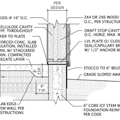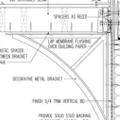Is code min really enough for unvented roofs?
In my readings of exterior insulation requirements for condensation control, I noticed the interior assumption is 70F @ 40RH.
However, is this really a realistic specification? Generally aren’t temps and humidity higher at the interior roof line due to moisture and heat stratification? It seems like the code didn’t really account for much of a safety margin, and when you consider clear night sky cooling of the roof, will code minimum really save your roof if you’re not diligent about interior RH as well?
I’m guessing the answer to this is the importance of an interior ceiling air barrier as well as the roof deck air barrier, maybe the codes may update to account for this one day…or am I missing something?
GBA Detail Library
A collection of one thousand construction details organized by climate and house part









Replies
For a given sample of air, raising the temperature will lower the relative humidity. Absolute humidity doesn't change much throughout a house so if it is warmer near the ridge, the relative humidity will be lower, with the same vapor pressure. In a well-sealed, well-insulated house, there is little stratification anyway.
The reason roofs are so much more troublesome than other exterior assemblies is that humidity rises. Water molecules are lighter than air.
That's debatable. Bill Rose largely disagrees: https://www.greenbuildingadvisor.com/article/high-humidity-in-unvented-conditioned-attics.
Michael,
Leaving that debate aside, compared to most walls, roofs also have both the stack effect and that they are covered with an exterior impermeable surface working against them.
what climate zone?